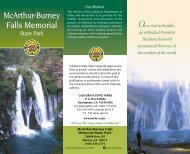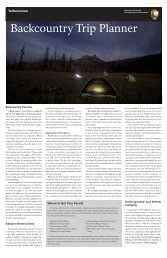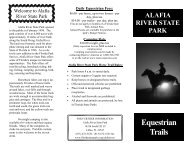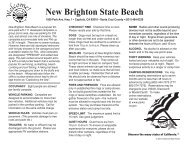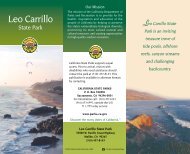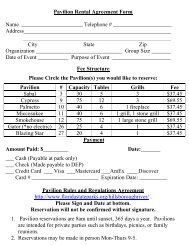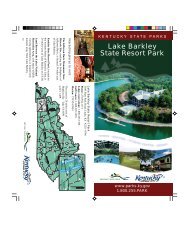Create successful ePaper yourself
Turn your PDF publications into a flip-book with our unique Google optimized e-Paper software.
Kïlauea <strong>Iki</strong> <strong>Trail</strong> <strong>Guide</strong><br />
Hawai‘i Volcanoes<br />
National Park<br />
$ 1 donation
Kïlauea <strong>Iki</strong> <strong>Trail</strong> <strong>Guide</strong><br />
Kïlauea <strong>Iki</strong> <strong>Trail</strong> <strong>Guide</strong><br />
Walk across a once-molten lake<br />
of lava in Kïlauea <strong>Iki</strong> Crater.<br />
Stops along this trail reveal the story of a dramatic<br />
eruption in 1959. A well-marked path leads you<br />
through lush rain forest along the rim of Kīlauea<br />
<strong>Iki</strong> (little Kīlauea) and down to its still-steaming<br />
crater floor.<br />
Start/End:<br />
Kīlauea <strong>Iki</strong> Overlook on Crater Rim Drive<br />
(recommended route is counterclockwise—<br />
to your right—from the overlook)<br />
Walking distance: 4 miles (6.4 km)<br />
Estimated walking time: 2–3 hours<br />
Elevation: 3,874 feet (1,180 m) above sea level<br />
Descent/Ascent:<br />
400 feet (122 m) with steps and switchbacks,<br />
equivalent to climbing down and up a<br />
40-story building<br />
<strong>Trail</strong> rating: Moderate<br />
For your safety and health:<br />
• stay on the trail<br />
• avoid unstable cliff edges<br />
• keep away from ground cracks<br />
• wear sturdy walking shoes<br />
• carry drinking water<br />
Weather conditions can change quickly. Take<br />
protective gear for sun and rain.
Kïlauea <strong>Iki</strong> <strong>Trail</strong> <strong>Guide</strong><br />
<strong>Trail</strong>head<br />
Welcome to Kīlauea <strong>Iki</strong>,<br />
one of the most popular trails<br />
in the park.<br />
As you hike the trail today, listen to the soothing forest<br />
sounds—birds singing, insects buzzing and trees blowing<br />
in the wind. In 1959, this tranquility was shattered by<br />
the deafening roar of lava blasting skyward in Kīlauea<br />
<strong>Iki</strong> Crater. People could hear the rumble—a sound like<br />
thunder and pounding surf combined—long before they<br />
could see erupting lava.<br />
Pele, the spiritual force of the<br />
volcano, had once again made<br />
her presence known. People<br />
come from all corners of the<br />
islands to witness her awesome<br />
power. Hawaiians observe her<br />
activity and create names that<br />
reflect her various moods.<br />
When she erupts within<br />
a crater, we know her as<br />
Kawaihineokalua, the<br />
woman of the pit. Flowing<br />
through the forests, she is<br />
Kawahine‘aihonua, eater of<br />
the land. Yet we need the land<br />
that she provides, so she is also<br />
Pelehonuamea, creator of<br />
new land.<br />
©ARTHOR JOHNSEN<br />
Can you see people on the crater floor?<br />
On your way to the first stop, peer into Kīlauea <strong>Iki</strong> to look for hikers on<br />
the trail below. Remember to keep a safe distance from the crater rim.
Kïlauea <strong>Iki</strong> <strong>Trail</strong> <strong>Guide</strong><br />
Kīlauea means “spewing,” and that’s<br />
exactly what happened here on the<br />
night of November 14, 1959.<br />
The eruption began when a<br />
“curtain” of lava burst from a<br />
half-mile (0.8 km) long fissure,<br />
or crack, in the crater wall<br />
directly across from you.<br />
Within a day, multiple vents<br />
along the fissure consolidated<br />
into one main vent (an opening<br />
through which lava erupts).<br />
USGS<br />
USGS<br />
Over the next five weeks,<br />
fountains of lava gushed<br />
from the vent in 17 separate<br />
episodes. Molten rock<br />
flooded the crater, creating<br />
a lake of lava that rose<br />
halfway up the crater walls,<br />
burying the initial fissure.<br />
Look at the hill on the opposite crater wall.<br />
This cinder-and-spatter cone, Pu‘u Pua‘i (gushing hill), did not<br />
exist prior to 1959. The reddish-brown cavity at the base of this<br />
cone was the main vent from which lava erupted.<br />
Imagine lava shooting five times higher than Pu‘u Pua‘i.<br />
Three days before the eruption ended, lava surged 1,900 feet<br />
(580 m) above the vent—a record for the highest fountain ever<br />
measured in Hawai‘i.
Kïlauea <strong>Iki</strong> <strong>Trail</strong> <strong>Guide</strong><br />
This concrete platform was the<br />
foundation of a trolley system used in<br />
research projects after the eruption.<br />
Kīlauea <strong>Iki</strong>’s lava lake provided a rare opportunity to study how<br />
molten rock cools and solidifies. By drilling into the lake’s<br />
solidified crust, scientists acquired data to help them<br />
understand processes within deep, inaccessible magma<br />
reservoirs—like the one beneath Kīlauea’s summit.<br />
You are here next to<br />
this concrete base.<br />
An old Jeep powered the trolley system. Workers suspended a steel cable<br />
from a tripod on the crater rim to an A-frame on the crater floor. Rope<br />
wrapped around a spool on the rear axle of the Jeep moved the trolley<br />
along the cable, transporting heavy equipment into and out of the crater.<br />
This ingenious system succeeded but almost certainly would not be<br />
approved under today’s stricter safety standards.<br />
Watch for ground cracks hidden by lush vegetation.<br />
As you walk to the next stop, you’ll cross a deep crack, one of<br />
many that opened up during the collapse of Kīlauea <strong>Iki</strong> Crater<br />
about 500 years ago. For your safety, please stay on the trail.
Kïlauea <strong>Iki</strong> <strong>Trail</strong> <strong>Guide</strong><br />
“The high crater rim . . . was drenched<br />
in glowing spatter during the night when<br />
an avalanche of cone debris deflected the<br />
jetting fountain across the lake.”<br />
D.H. Richter, USGS*<br />
When you put your thumb across the end of a gushing hose,<br />
water doesn’t stop flowing —it spurts out in different directions.<br />
Similarly, when slabs of rock blocked Kīlauea <strong>Iki</strong>’s gushing vent,<br />
lava fountains were deflected.<br />
USGS<br />
The bombardment lasted only<br />
20 minutes, but in that short<br />
time, Pele lived up to another<br />
of her names: Kawahine‘aila‘au,<br />
woman who eats trees. Spatter<br />
completely denuded the forest<br />
here. Most of the plants you see<br />
today sprouted from seeds that<br />
colonized the molten rock after<br />
it cooled.<br />
During one eruptive episode,<br />
spatter (blobs of molten rock)<br />
up to three feet (one meter) in<br />
diameter shot across the crater<br />
and landed where you are<br />
standing. Fortunately,<br />
no spectators were at this<br />
often-crowded vantage point<br />
that night.<br />
USGS<br />
Did you feel a difference in the trail surface as you<br />
approached this stop?<br />
Spatter forms the lumpy black rock beneath your feet. Notice how<br />
the path changes when you walk out of the spatter fallout area.
Kïlauea <strong>Iki</strong> <strong>Trail</strong> <strong>Guide</strong><br />
“Pumice from the fountain continued to<br />
fall like black rain . . . accumulating<br />
rapidly on the rim of the crater . . . where a<br />
new cinder cone was beginning to grow.”<br />
D.H. Richter, USGS*<br />
Pause here to enjoy a magnificent view of Pu‘u Pua‘i. With each<br />
high fountain, fragments of frothy lava (cinder) and blobs of<br />
molten rock (spatter) piled up on the crater rim, forming this<br />
cinder-and-spatter cone.<br />
Pu‘u Pua‘i<br />
Uwëaloha<br />
Halema‘uma‘u<br />
Crater<br />
Mauna Loa<br />
Jaggar Museum<br />
Vent<br />
Uwēaloha (Byron Ledge), a tree-covered ridge, separates Kīlauea<br />
<strong>Iki</strong> Crater from Kīlauea summit caldera. On the floor of this large<br />
depression, you can see Halema‘uma‘u Crater, home of the volcano<br />
goddess Pele. Jaggar Museum and the USGS Hawaiian Volcano<br />
Observatory are perched on the caldera rim. Mauna Loa, the<br />
islands most massive volcano, is visible from here on clear days.<br />
Look and listen for ‘apapane in<br />
the ‘öhi‘a trees below.<br />
These crimson honeycreepers sip nectar<br />
from red lehua blossoms and fill the<br />
forest with melodious songs and whistles.<br />
Stand quietly to hear the distinct whir of<br />
their wings as these native birds fly past.<br />
©JACK JEFFREY<br />
Caution: Rocky slope ahead.<br />
The trail cuts through a section of large boulders shaken<br />
loose from cliffs during powerful earthquakes in 1975 and 1983<br />
(magnitude 7.2 and 6.8, respectively).
Kïlauea <strong>Iki</strong> <strong>Trail</strong> <strong>Guide</strong><br />
Spared by the 1959 eruption, this forest<br />
has been subjected to other destructive<br />
forces—non-native plants and animals.<br />
Downwind from high lava fountains, forests suffered<br />
tremendous damage. Trees were stripped of leaves and<br />
branches—or completely buried—by falling cinder. Prevailing<br />
trade winds blew most of the cinder away from here, sparing<br />
this forest from the eruption. Protecting it from invasive flora and<br />
fauna has required human intervention.<br />
©JANET BABB<br />
A conspicuous non-native plant along the<br />
trail is kāhili ginger. This weed is even more<br />
noticeable when its fragrant yellow flowers<br />
bloom in late summer. Efforts to eradicate<br />
ginger are in progress, but dangerous ground<br />
cracks in this area make the work difficult.<br />
Feral pigs (domestic pigs gone wild) stomped and chomped<br />
their way through this forest until 1980, when park resources<br />
management crews built fences to keep them out. Pig fences are<br />
expensive to build—up to $35,000 per mile—but they work.<br />
Protected from feral pigs, this forest is showing signs of<br />
recovery. Delicate native plants that survive only in pig-free<br />
areas are now growing here.<br />
Look for pa‘iniu along the trail.<br />
Pa‘iniu, one of the few native lilies<br />
in Hawai‘i, can grow on the ground<br />
now that pigs and kāhili ginger have<br />
been removed.<br />
©JOAN YOSHIOKA<br />
HNHA
Kïlauea <strong>Iki</strong> <strong>Trail</strong> <strong>Guide</strong><br />
Prior to 1959, you would be looking into<br />
a forest-covered crater 800 feet (244 m)<br />
deep, twice the present depth.<br />
The black rock that forms the crater floor is actually the surface<br />
of the lava lake that flooded Kīlauea <strong>Iki</strong>. Don’t worry about<br />
walking across the crater—the lake is now solid.<br />
Stop to look for<br />
slump scars on Pu‘u Pua‘i.<br />
As you make your way into<br />
the crater, look for grooves<br />
cut into the side of the cinder-and-spatter<br />
cone. How<br />
did they get there? Read on.<br />
Cinder and spatter rapidly<br />
accumulated to form Pu‘u<br />
Pua‘i (gushing hill). Perched<br />
precariously on the crater rim,<br />
oversteepened slabs of congealed<br />
spatter occasionally broke loose<br />
and slid down the cone, exposing<br />
its yellow-hot interior. Pulled<br />
by gravity, the slabs scraped and<br />
scratched groove marks in semimolten<br />
rock beneath the cone’s<br />
cooling surface.<br />
USGS<br />
Caution: Uneven steps ahead.<br />
Walk carefully as you make your way down to the crater floor.
Kïlauea <strong>Iki</strong> <strong>Trail</strong> Map<br />
To preserve Hawai‘i Volcanoes<br />
National Park for the enjoyment of<br />
present and future generations, do not<br />
collect or disturb natural, cultural,<br />
or historical features.<br />
Please help protect<br />
your park . . .<br />
take only photographs<br />
and inspiration, leave<br />
only footprints<br />
and goodwill.<br />
Cra ter Rim Drive<br />
Devastation<br />
<strong>Trail</strong><br />
Pu‘u Pua‘i<br />
Byron Ledge<br />
To caldera<br />
floor<br />
To Volcano House<br />
and Visitor Center<br />
AHU<br />
Thurston<br />
Lava Tube<br />
(Nāhuku)<br />
North<br />
Kīlauea <strong>Iki</strong><br />
Overlook<br />
<strong>Trail</strong>head<br />
Ahu (stacked rocks)<br />
mark the trail<br />
across the crater<br />
floor. Please do<br />
not disturb them<br />
or build new ones.<br />
TRAIL STOPS<br />
Ground markers on lava or<br />
numbered posts in the forest<br />
indicate stops<br />
described in<br />
this guide.<br />
0.5 miles (0.8 km)
Kïlauea <strong>Iki</strong> <strong>Trail</strong> <strong>Guide</strong><br />
You are standing on a rocky ledge known<br />
as a “bathtub ring.” In geologic terms, it’s<br />
called a lava subsidence terrace.<br />
When the lava lake grew higher than the vent, fountains stopped<br />
erupting. Molten lava then drained back into the vent, dragging<br />
pieces of the lake’s crust with it. Lava often poured back into<br />
the vent four times faster than it was erupted, generating a noisy<br />
whirlpool of red-hot, liquid lava and black slabs of solid rock.<br />
USGS<br />
“. . . a constant clatter and<br />
rumble was audible as the<br />
thickening crust was crumpled<br />
and dragged toward the vent<br />
by the retreating lava.”<br />
D.H. Richter, USGS*<br />
Lush forests survived above<br />
the lake’s high lava mark.<br />
As the lake partially drained,<br />
its surface dropped nearly<br />
50 feet (15 m), leaving<br />
behind a crusty lava<br />
“bathtub ring” to indicate<br />
its highest level.<br />
Can you see glassy green crystals of olivine in<br />
the rocks here?<br />
Hawaiian lava contains the mineral olivine, but the crystals are<br />
often too small to see without a microscope. Enjoy looking at<br />
the olivine crystals, but remember to leave them in place.
Kïlauea <strong>Iki</strong> <strong>Trail</strong> <strong>Guide</strong><br />
With temperatures up to 2,200˚ F<br />
(1,217˚ C), Kīlauea <strong>Iki</strong> erupted the hottest<br />
lava ever measured on the volcano.<br />
Throughout the eruption, Hawaiian Volcano Observatory<br />
scientists entered the crater daily, but never without a clear line<br />
of retreat to escape from deadly fumes and blistering cinders.<br />
They risked scorched gloves and charred boots to measure<br />
temperatures and collect samples of gas and lava to help them<br />
better understand the inner workings of Kīlauea Volcano.<br />
USGS<br />
“We were continually<br />
broiled by radiant heat<br />
from the fountain and<br />
flows and were bathed in<br />
strong, at times choking,<br />
sulfur dioxide fumes . . .”<br />
D.H. Richter, USGS*<br />
You are walking through rough, unstable rock that looks like the<br />
jumbled ‘a‘ā lava you see elsewhere in the park. But this rock<br />
is not ‘a‘ā. It formed when welded spatter (blobs of molten lava<br />
fused together) broke apart as it slid down the cone, rolling and<br />
tumbling into coarse, jagged pieces of rock. Watch your step on<br />
the uneven trail.<br />
Gaze skyward to look for<br />
koa‘e kea (white-tailed tropicbird)<br />
gliding above the crater.<br />
These graceful birds nest in rocky cliffs<br />
around Kīlauea <strong>Iki</strong> but fly to the ocean<br />
to feed.<br />
©JACK JEFFREY
Kïlauea <strong>Iki</strong> <strong>Trail</strong> <strong>Guide</strong><br />
You are standing at the lip of the main<br />
vent. Fallen rocks cover the actual opening<br />
through which lava erupted 17 times.<br />
Each episode of the eruption played out differently. Some went<br />
on for days, while others lasted only hours. Molten rock<br />
sometimes poured from the vent in a rolling boil. At other<br />
times, lava burst skyward to form towering fountains in a<br />
matter of seconds.<br />
USGS<br />
“. . . incandescent clots of gasinflated<br />
lava glow bright orange<br />
as they spurt skyward . . . then<br />
darken rapidly through tones of<br />
red to steely gray as they plummet<br />
back to the earth.”<br />
D.H. Richter, USGS*<br />
Every episode ended with lava draining back into the vent.<br />
The rock beneath your feet—slabs of the lake’s crust—stacked<br />
up as lava drained from the crater. These brittle layers broke<br />
and pulled apart as they slumped into the vent, creating the<br />
dangerous cracks and unstable rock layers in front of you.<br />
The rocks here weigh less than you might expect because they<br />
contain numerous holes left by gas bubbles in the frothy lava.<br />
If you pick up a rock, watch out for its razor-sharp edges, and be<br />
sure to leave it where you found it.<br />
Note the variety of colors in rocks around the vent.<br />
In a process similar to the way water rusts a nail, volcanic gases<br />
oxidize iron-rich minerals in lava, creating shades of red, purple<br />
and brown in the rocks.
Kïlauea <strong>Iki</strong> <strong>Trail</strong> <strong>Guide</strong><br />
10<br />
Fractures in the crater floor widen<br />
(or close) as the lava lake continues<br />
to slowly cool and subside.<br />
When molten lava drained back into the vent, the lake’s crust<br />
collapsed 50 feet (15 m) or more. As it dropped into deeper parts<br />
of the crater, the rigid crust buckled and cracked, creating the<br />
uneven rocky ridges you see here.<br />
Today, the crater floor continues to subside about 3/4 inch (2 cm)<br />
per year as the hot interior of the lava lake slowly cools and contracts.<br />
“Under the continued rain of pumice and<br />
cinder, the cone was growing rapidly . . .<br />
and becoming very unstable.”<br />
D.H. Richter, USGS*<br />
Raised terraces flanking the trail probably formed when huge<br />
blocks of Pu‘u Pua‘i slid into the lava lake. Slowly rafted from<br />
the cone by gushing lava, these “floating islands” came to rest<br />
here. Each time the lake level rose, they were covered by molten<br />
lava. When lava drained back into the vent, the blocks were again<br />
exposed as terraces standing above the surrounding lake surface.<br />
You often see steam rising from the terraces and cracks in the<br />
crater floor. Steam forms when rainwater percolates down to hot<br />
rock below the surface and vaporizes. Steaming cracks attract<br />
visitors on cold, windy days, but beware! The steam is scalding hot.<br />
Did you notice chalky white streaks on the black rock?<br />
These white deposits form when dissolved minerals, primarily<br />
calcium sulfates and silica, are carried to the surface by steam.
Kïlauea <strong>Iki</strong> <strong>Trail</strong> <strong>Guide</strong><br />
Kīlauea <strong>Iki</strong>’s lava fountains were<br />
impressive, but the real story of this<br />
eruption was the rapidly rising lava lake.<br />
With no outlet from the crater, lava flooded Kīlauea <strong>Iki</strong>. During<br />
the first episode alone, 68 million tons of lava poured into the<br />
crater, creating a lake several hundred feet deep. By the time the<br />
eruption ended on December 20, another 18 million tons of lava<br />
were added to the crater, increasing the lake depth to over 400<br />
feet (120 m). The enormous weight of this lava lake is 235 times<br />
heavier than the Empire State Building.<br />
USGS<br />
“. . . a dark crust<br />
formed rapidly on<br />
the glowing lava, and<br />
incandescence was<br />
restricted to the<br />
ever-changing pattern<br />
of cracks that<br />
crisscrossed the [lake’s]<br />
surface.”<br />
D.H. Richter, USGS*<br />
The lake’s surface quickly cooled to form a thin black crust that<br />
readily broke into plates 10 –20 feet (3– 6 m) across. Cracks<br />
between the plates were immediately filled by less dense molten<br />
lava rising from beneath the crust. As frothy orange-hot lava<br />
oozed over the rigid plates, they were “swallowed” into the lake.<br />
This process of “crustal overturning” moved across the entire<br />
lake in a matter of minutes. It occurred many times during the<br />
eruption and for almost a week after it ceased. You are walking<br />
on a surface created by the final overturn of the lake.
Kïlauea <strong>Iki</strong> <strong>Trail</strong> <strong>Guide</strong><br />
Based on cooling rates measured through<br />
repeated drilling projects, scientists believe<br />
the lava lake was solid by the mid-1990s.<br />
Scientists first drilled into Kīlauea <strong>Iki</strong>’s lava lake four months after<br />
the eruption ended. Drilling stopped abruptly at a depth of only<br />
nine feet (2.7 m), when red-hot lava oozed up the borehole. With<br />
each passing year, the crust grew thicker.<br />
As the lava cooled from outside<br />
to inside, zones of molten rock<br />
within the lake decreased in size.<br />
By 1988, the last time scientists<br />
drilled into the lake, only traces<br />
of melt remained at depths<br />
of 240–330 feet (73–100 m).<br />
Although the lake is now entirely<br />
solid, it’s still hot inside.<br />
SOUTH<br />
440 feet(135 m)<br />
2,10 feet(640 m)<br />
1967<br />
1975<br />
1981<br />
Cross section of lava lake<br />
(vertical exaggeration 2:1)<br />
NORTH<br />
The 1988 drilling project revealed a surprising discovery: Kīlauea<br />
<strong>Iki</strong>’s lava lake is deeper than originally projected. The old crater<br />
floor apparently subsided into the underlying magma reservoir.<br />
No collapse was observed during the eruption, so the crater must<br />
have gradually “floated down” as molten rock erupted from the<br />
reservoir. The lava lake is now estimated to be 440 feet (135 m) deep.<br />
Drill holes are still visible 175 feet (50 m) to the left of this stop.<br />
You can step off the trail for a closer look, but approach<br />
boreholes with care. Many of them emit scalding steam.<br />
Look for evidence of rockslides ahead.<br />
Kīlauea <strong>Iki</strong>, changed forever by the 1959 eruption, continues to<br />
be shaped by catastrophic events. Huge boulders from its<br />
unstable walls tumbled down to the crater floor during the<br />
1975 and 1983 earthquakes.
Kïlauea <strong>Iki</strong> <strong>Trail</strong> <strong>Guide</strong><br />
“The fountain blasting through fluid lava . . .<br />
generated large waves . . . which traveled the<br />
short distance across the lake to the opposite<br />
shore where they broke like waves on a beach.”<br />
D.H. Richter, USGS*<br />
As you climb back up the “bathtub ring,” turn around and gaze<br />
across Kīlauea <strong>Iki</strong>. Picture this crater as it was in November<br />
1959—a rolling lake of molten rock, with waves of incandescent<br />
lava washing up this ledge.<br />
Envision high lava fountains illuminating the night sky and Pu‘u<br />
Pua‘i growing larger as cinder and spatter rained down on the<br />
crater rim. Imagine the searing heat and thundering roar of lava<br />
bursting from the vent. Think about future eruptions and how<br />
Kīlauea <strong>Iki</strong> may look a century from now.<br />
NPS/CHARLENE MEYERS<br />
As Pele creates new land, her sister<br />
Hi‘iakaikapoliopele brings life to<br />
the barren lava. Note how ‘ōhi‘a and<br />
other plants are revegetating the lava.<br />
Wind-blown seeds take root in cracks<br />
where moisture and nutrients collect.<br />
Given enough time, trees and shrubs<br />
will create a forest like the one buried<br />
beneath this lake of lava.<br />
Watch for ‘io<br />
(Hawaiian hawks).<br />
If you’re lucky, you may see an<br />
endangered ‘io soaring on air currents<br />
above Kīlauea <strong>Iki</strong>’s forested crater walls.<br />
©JACK JEFFREY
Kïlauea <strong>Iki</strong> <strong>Trail</strong> <strong>Guide</strong><br />
Explore a lava tube where molten<br />
rock flowed around 500 years ago.<br />
It’s just across the road.<br />
If you have time, walk through Thurston Lava Tube (Nāhuku)<br />
before returning to your car. As you walk along the path to this<br />
cave-like feature, listen and look for native birds in the rain forest.<br />
Restrooms and a water fountain are available<br />
across the road.<br />
To go directly back to Kīlauea <strong>Iki</strong> Overlook, where you started<br />
your hike, follow the sidewalk until you reach the Crater Rim<br />
<strong>Trail</strong>head—to your left near the end of the line of parked cars.<br />
Peer into Kïlauea <strong>Iki</strong> from crater rim overlooks.<br />
As you walk the last half-mile (0.8 km) of the trail, linger a<br />
moment at each overlook to savor your experience of walking<br />
through a dynamic, ever-changing volcanic crater.<br />
Credits<br />
* Quotes are from Hawaiian Volcano Observatory scientists<br />
who monitored the 1959 eruption from beginning to end.<br />
Their observations are recorded in the U.S. Geological<br />
Survey Professional Paper 537-E, Chronological Narrative of<br />
the 1959–60 Eruption of Kilauea Volcano, Hawaii by<br />
D.H. Richter and others, 1970 (available online through<br />
the USGSPublications Warehouse).<br />
Eruption photos courtesy of the USGS Hawaiian Volcano<br />
Observatory. Lava lake cross section diagram provided by<br />
Rosalind Helz, USGS National Center, Reston, Virginia.
Kïlauea <strong>Iki</strong> <strong>Trail</strong> <strong>Guide</strong><br />
Thank you for visiting Hawai‘i Volcanoes<br />
National Park. We hope you enjoyed your<br />
hike through Kīlauea <strong>Iki</strong> Crater.<br />
• What will you remember most about Kīlauea<br />
<strong>Iki</strong> and its 1959 eruption?<br />
• Were you surprised by anything you saw or<br />
learned during your hike?<br />
• If you could spend more time here, which part<br />
of the trail would you revisit?<br />
• How will you share your experience with<br />
friends and family?<br />
For more information<br />
To read more about Kīlauea <strong>Iki</strong> and other<br />
historical eruptions in Hawai‘i, i, go to the<br />
USGS Hawaiian Volcano Observatory<br />
website: hvo.wr.usgs.gov.<br />
To learn more about Hawai‘i Volcanoes National<br />
Park, visit our website: www.nps.gov/havo.<br />
For books, videos, DVDs and other materials<br />
about Hawai‘i i Volcanoes National Park, visit<br />
bookstores in the Kīlauea Visitor Center and<br />
Jaggar Museum, or visit their website at:<br />
www.hawaiinaturalhistory.org<br />
Hawai‘i Natural History Association<br />
P.O. Box 74<br />
Hawaii National Park, HI 96718<br />
Tel: 808-985-6051<br />
E-mail: havo_hnha@nps.gov<br />
Printed on recycled paper with soy-based ink<br />
Produced by the Interpretive Planning and Media Development Branch<br />
Hawai‘i Volcanoes National Park<br />
4/08




